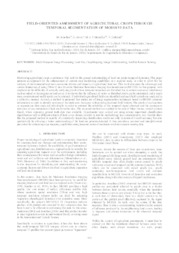Field-oriented assessment of agricultural crops through temporal segmentation of modis VI data.
Field-oriented assessment of agricultural crops through temporal segmentation of modis VI data.
Author(s): JONATHAN, M.; ARVOR, D.; MEIRELLES, M. S. P.; DUBREUIL, V.
Summary: Monitoring agricultural crops constitutes a vital task for the general understanding of land use spatio-temporal dynamics. This paper presents an approach for the enhancement of current crop monitoring capabilities on a regional scale, in order to allow for the analysis of environmental and socio-economic drivers and impacts of agricultural land use. This work discusses the advantages and current limitations of using 250m VI data from the Moderate Resolution Imaging Spectroradiometer (MODIS) for this purpose, with emphasis in the difficulty of correctly analyzing pixels whose temporal responses are disturbed due to certain sources of interference such as mixed or heterogeneous land cover. It is shown that the influence of noisy or disturbed pixels can be minimized, and a much more consistent and useful result can be attained, if individual agricultural fields are identified and each field's pixels are analyzed in a collective manner. As such, a method is proposed that makes use of image segmentation techniques based on MODIS temporal information in order to identify portions of the study area that agree with actual agricultural field borders. The pixels of each portion or segment are then analyzed individually in order to estimate the reliability of the temporal signal observed and the consequent relevance of any estimation of land use from that data. The proposed method was applied in the state of Mato Grosso, in mid-western Brazil, where extensive ground truth data was available. Experiments were carried out using several supervised classification algorithms as well as different subsets of land cover classes, in order to test the methodology in a comprehensive way. Results show that the proposed method is capable of consistently improving classification results not only in terms of overall accuracy but also qualitatively by allowing a better understanding of the land use patterns detected. It thus provides a practical and straightforward procedure for enhancing crop-mapping capabilities using temporal series of moderate resolution remote sensing data.
Publication year: 2008
Types of publication: Paper in annals and proceedings
Unit: Embrapa Soils
Observation
Some of Embrapa's publications are published as ePub files. To read them, use or download one of the following free software options to your computer or mobile device. Android: Google Play Books; IOS: iBooks; Windows and Linux: Calibre.
Access other publications
Access the Agricultural Research Database (BDPA) to consult Embrapa's full library collection and records.
Visit Embrapa Bookstore to purchase books and other publications sold by Embrapa.

